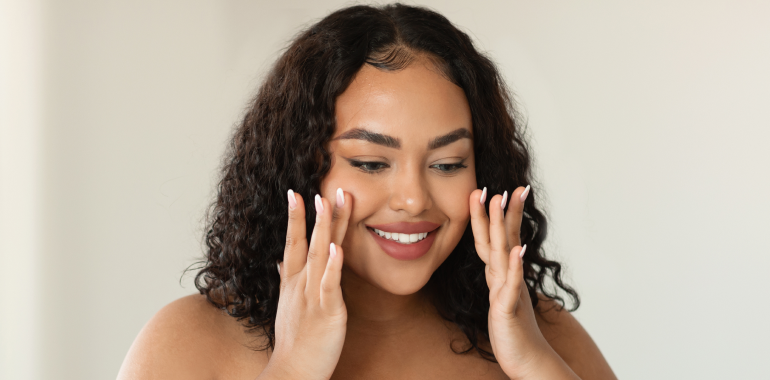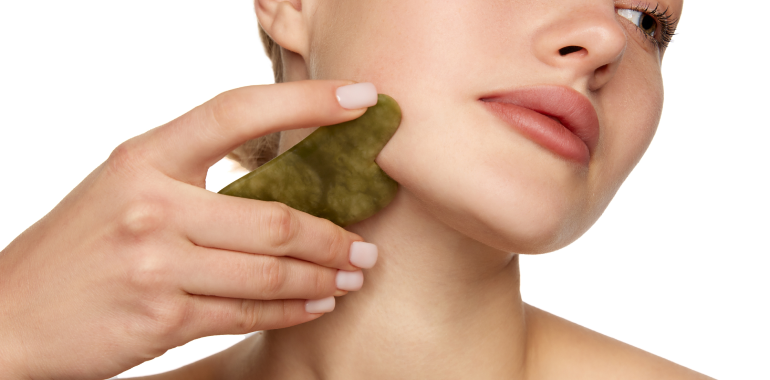Table Of Contents
Intro to Face Fat: Real Differences Between Before and After
Have you ever stared at your reflection wondering what you’d look like with a slimmer, more defined face? You’re not alone. The desire to reduce facial fullness is incredibly common, but understanding the journey from ‘before’ to ‘after’ requires clarity about what actually changes during facial transformation.
In this comprehensive guide, I’ll demystify the process of facial slimming and reveal the truth behind those dramatic transformations. From genetic influences to lifestyle modifications that shape your facial structure, I’ll cover everything you need to know about reducing face and neck fat effectively.
Let’s uncover the real differences between the ‘before’ and ‘after’ results that can completely transform your appearance and confidence!
Unmasking Double Chin Reduction Methods: Exercises & Medical Treatments
A common concern called “double chin,” or submental fullness in medical terminology, develops when fat accumulates beneath the chin. While often associated with weight gain, you don’t need to be overweight to have one. Double chins can also result from aging or genetic factors. Your family history may predispose you to less elastic skin or a propensity for developing a double chin.
Also, read – Looking for a Wall Pilates App? Check Out…

Chin Chiseling 101: Effective Techniques for a Slimmer Profile
Several approaches can help eliminate a double chin, ranging from targeted exercises to professional medical interventions.
- Exercises such as chin lifts, neck rolls, and tongue stretches can strengthen and tone the jaw and neck muscles, reducing the appearance of a double chin.
For optimal results, perform these movements correctly and consistently. Follow these techniques to avoid strain while working on a slimmer facial profile:
1. Chin lifts require tilting your head backward to face the ceiling, puckering your lips as if kissing the ceiling, holding for 10 seconds, then returning to the starting position.
2. Neck rolls involve gently rotating your head clockwise and then counter-clockwise while maintaining a straight spine.
3. Tongue stretches:
Extend your tongue as far as possible.
Lift it toward your nose.
Hold for 10 seconds before relaxing.
4. Medical treatments like Kybella and CoolSculpting offer FDA-approved solutions with lasting results. Kybella injections destroy fat cells under the chin, while CoolSculpting freezes and eliminates fat cells with a handheld device.
Both treatments have advantages and drawbacks, with potential side effects including bruising, swelling, and numbness. Consider factors like age, skin elasticity, and overall health before pursuing these treatments.
How to Lose Neck Fat Fast: Strategies for a Defined Neckline
Neck fat can be particularly challenging to address because it stems from multiple factors. Let me explain why neck fat accumulates and how it differs from general body fat.
First, understand that neck fat doesn’t necessarily reflect your overall body fat percentage. Research from Nature.com discovered that neck fat can vary significantly in its properties. While weight gain contributes to neck fat, other factors including diet, posture, and genetics play important roles.
Specific dietary habits might cause more fat storage in the neck region. A study in ScienceDirect indicated that the source of dietary energy could affect weight distribution across different body areas, including the neck.
Here are effective strategies to combat neck fat and learn how to lose neck fat fast:
Also, read – Find Your One Between 15 Best Calorie Tracker
Face and Neck Fat: The Road to Reduction
Whole-Body Weight Loss Approach
The foundation for losing fat anywhere on your body, including your neck, is creating a caloric deficit—consuming fewer calories than you burn. A review in the Journal of the Academy of Nutrition and Dietetics confirmed that a sustainable, calorie-reduced diet paired with regular physical activity provides the most effective long-term results for weight management.
Dietary Changes That Make a Difference
Your diet significantly impacts where and how your body stores fat. Maintaining a healthy weight becomes easier when you consume a balanced diet rich in fruits, vegetables, whole grains, and lean proteins within your daily calorie limits. This approach can help minimize face and neck fat accumulation when you stick to portion-controlled meals.
Targeted Exercises for Maximum Impact
While spot-reducing fat from specific areas isn’t possible, incorporating exercises that tone and strengthen the facial and jawline muscles improves the area’s appearance and enhances the neck region. These targeted movements can create a more sculpted look when performed consistently.
Why Crash Diets Don’t Work
Quick-fix diets might promise rapid results, but they typically lead to muscle loss and can harm your health. Gradual, consistent weight loss proves healthier and more sustainable in the long run, while rapid weight fluctuations often result in regaining the lost pounds.
Good Posture for Neck Fat Prevention
Maintaining proper posture is essential for strengthening neck muscles and preventing fat accumulation. Keep your chin up and shoulders back to support neck muscle development and create a more defined profile.
Essential Vitamins for Facial Fat Reduction and Jawline Definition
- Vitamin C
This fundamental nutrient supports collagen production, which maintains skin firmness and elasticity for a more youthful appearance.
- Vitamin E
Contains antioxidants that protect skin from damage and help combat sagging appearance by preserving skin integrity.
- Vitamin A
Renowned for its anti-aging benefits, vitamin A promotes healthy skin and can reduce facial puffiness by supporting skin renewal.
- B-Vitamins
B vitamins, especially B-6 and B-12, help reduce water retention and bloating, which can minimize facial fullness and create a more defined appearance.
Understanding Facial Asymmetry: Why One Side of Your Face Might Be Fatter
First, minor asymmetry is perfectly normal—most faces aren’t completely symmetrical. However, more noticeable differences may result from various factors:
1. Tooth alignment. Your jawline forms a crucial part of your facial structure, and any misalignment can make one side appear more prominent.
2. Injuries. Facial trauma or injury can cause swelling or alter bone structure, making one side of the face look larger.
3. Sinus infections. These can trigger swelling or puffiness on one side of the face, depending on where the infection is located.
4. Habits. Poor nutrition, insufficient exercise, alcohol consumption, smoking, and other lifestyle factors can contribute to uneven weight gain and water retention affecting facial appearance.
6. Sleeping habits. Consistently sleeping on one side may cause that side to appear slightly puffier due to overnight fluid accumulation.
Dietary Downfalls: Foods That Contribute to Face Fat
- Processed foods – contain high sodium levels that lead to water retention and bloating.
- Alcohol – dehydrates your body and can cause facial puffiness.
- Sugary foods and drinks – trigger inflammation throughout the body, resulting in bloating, including in the face.
- Dairy products – can cause bloating and gas for those with lactose intolerance.
- High-sodium foods – like canned soup, deli meats, and pre-packaged meals typically contain excessive salt, which causes water retention.
- Certain vegetables – including broccoli, cabbage, and onions, may cause gas and bloating in some individuals.
- Beans and lentils – high fiber content can cause gas and bloating.
- Carbonated drinks – bubbles trap gas in your digestive system, leading to bloating.
Also, read – 15 Best Nutrition Apps of Today
7-Day Plan: How to Lose Neck Fat Fast in a Week
Day 1: Hydration and Nutrition Foundation
- Morning: Start your day with warm lemon water to jumpstart metabolism.
- Throughout the day: Increase water intake to at least eight glasses to flush out toxins.
- Diet: Focus on high-protein, low-carb meals. Include lean meats, fish, and plenty of green vegetables while avoiding processed foods and sugar.
Day 2: Exercise Routine Intensification
- Morning: Complete a 30-minute cardiovascular workout—brisk walking, jogging, or cycling to boost fat burning.
- Evening: Incorporate neck and shoulder stretches to tone muscles and improve flexibility.
Day 3: Mindful Eating and Strength Training
- Diet: Practice mindful eating to learn how to lace all face and neck fat easly. Chew slowly, savor your food, and stop eating before feeling completely full to prevent overeating.
- Workout: Add strength training to your routine. This impacts body composition, indirectly affecting neck fat. Push-ups, squats, and lunges are effective and can be performed anywhere.
Day 4: Sleep and Stress Management
- Lifestyle: Ensure 7-9 hours of quality sleep to support hormonal balance and recovery.
- Stress management: Practice meditation or yoga to lower stress levels and reduce cortisol production.
Day 5: High-Intensity Interval Training
- Workout: HIIT workouts efficiently promote rapid fat loss. Include a 20-minute session with exercises like high knees, burpees, and jump squats to accelerate metabolism and enhance facial definition.
Day 6: Posture Correction Techniques
- Throughout the day: Maintain proper posture by sitting straight with shoulders back to engage neck muscles.
- Evening: Repeat neck and shoulder stretches to maintain muscle tone and flexibility.
Day 7: Progress Assessment and Future Planning
- Reflection: Evaluate your progress and how you feel. Note any changes in your neck appearance or clothing fit.
- Planning: Set goals for the upcoming weeks to maintain momentum and continue improvements.
Why Is My Face Getting Fat but Not My Body? The Facial Fat Phenomenon
1. Water Retention
One primary cause of facial bloating is water retention. Consuming excessive sodium, inadequate hydration, or hormonal fluctuations can cause your body to retain water, often appearing first in facial tissues.
2. Lack of Sleep
Insufficient rest can trigger facial bloating. Sleep deprivation increases cortisol production, a stress hormone that promotes water retention and facial puffiness.
3. Aging
As we age, skin elasticity decreases and muscle mass diminishes. This natural process can cause facial features to sag slightly, creating the impression of increased fullness.
4. Genetics
Some people naturally have fuller faces regardless of their body size due to inherited facial structure and fat distribution patterns.
Also, read – How to Get the Energy to Workout
Three Super-Practices for Facial Fullness and Definition
Best 1: Cheek Lifts
- How to do it? Smile as widely as possible without opening your mouth. Raise your cheeks toward your eyes as much as you can until you feel your cheek muscles burning. Hold this position for about 10 seconds, then relax. Repeat this exercise 10-15 times to strengthen facial muscles.
Best 2: Jaw Release
- How to do it? Sit or stand with proper posture. Make chewing motions with closed lips. Then, open your mouth wide while pressing your tongue against your lower teeth. Hold for about 5 seconds, close your mouth, and take a deep breath. Repeat 10-15 times to tone jaw muscles.
Best 3: Eyebrow Raises
- How to do it? Maintain proper posture while sitting or standing. Raise your eyebrows as high as possible and hold for about 5 seconds before relaxing. Repeat 10-15 times to engage forehead muscles and improve facial tone.

Sculpting Your Jawline: Effective Techniques That Last
- Jaw Exercises
Basic movements like opening and closing your mouth, pushing your lower jaw forward, and side-to-side jaw movements can strengthen jawline muscles effectively.
- Chewing Gum
Sugar-free gum provides a simple yet effective way to exercise jaw muscles while helping to curb mindless snacking throughout the day.
- Eat Crunchy Foods
Foods requiring more chewing effort, such as apples, carrots, and celery, naturally exercise your jaw while providing nutritional benefits.
- Facial Yoga
Specific facial yoga poses like “The Lion Face” and “The Fish Face” help tone facial and jaw muscles for improved definition and contour.
- Avoid Teeth Grinding
Teeth grinding places unnecessary stress on your jaw. Consider using a mouthguard or other management techniques if this is an ongoing issue.
- Regular Breaks
When working at a desk all day, take brief breaks to relax your facial and jaw muscles, preventing tension buildup and muscle fatigue.
- Massages
Regular jawline massages improve blood circulation and release tension, promoting healthier, stronger jaw muscles over time.
- Jawzrsize
This specialized device works out facial muscles like a resistance tool for your jaw. Use with caution and moderation, as excessive use may cause jaw discomfort.
Also, read – Transformative Yoga Challenge: Find Your Inner Zen
The Complete Guide to Face and Neck Fat Reduction: Key Takeaways
Reducing face and neck fat requires a personalized approach rather than a universal solution. From consistent hydration and clean eating to targeted exercises for facial muscles and quality sleep—numerous natural methods can help sculpt your facial features.
Success comes from consistency, healthy habits, and sometimes professional guidance. The combination of these elements creates the most effective long-term strategy for facial definition.
Don’t underestimate the power of facial massages in boosting circulation and lymphatic drainage, which significantly contributes to a slimmer, more defined face. These simple techniques, when performed regularly, can enhance your facial contours and create a more sculpted appearance over time.
Chris is a certified exercise physiologist with over 13 years of experience in fitness and wellness. With a Master of Science in Exercise and Wellness, Chris has been a educating the public as a writer, editor, and trainer. He is passionate about creating evidence-based content in an engaging way to make learning fun.









